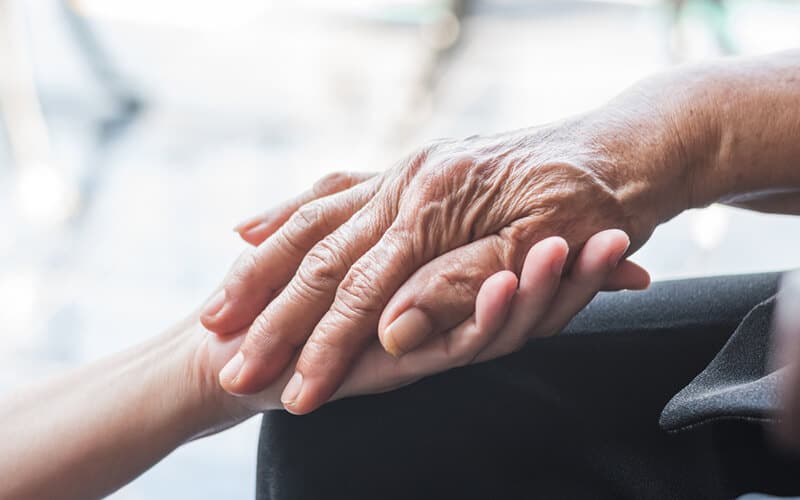Parkinson’s Disease Symptoms

Parkinson’s disease is a degenerative nervous system disorder, meaning it worsens with time. The common age of onset is usually after age 60, and while Parkinson’s disease symptoms have been known to appear in individuals in their 20s, this is extremely rare. People who experience Parkinson’s symptoms in their 50s or earlier are said to have early-onset Parkinson’s. The causes of Parkinson’s are thought to be genetic, meaning gene mutations are involved. Some cases appear to be hereditary, though many are not.
Much is unknown about Parkinson’s disease including why men are more likely to develop the disease than women. For the present, no definitive diagnostic tool or blood test exists to determine whether or not a patient has the disorder, and so doctors rely on the patient’s medical history and the manifestation of one or more of the four main symptoms of Parkinson’s disease to begin early treatment while it is in its early stage in hopes of slowing its progression.
The Four Main Symptoms of Parkinson’s Disease
- Tremors that may develop in the hands, head, jaw, or legs.
- Balancing and coordination issues that cause falls.
- Slowed movement
- Muscle stiffness or prolonged muscle contractions.
Stages And Symptoms Of Parkinson’s Disease
Parkinson’s disease progresses over time and affects individuals at differing rates. The earliest Parkinson’s symptoms are often subtle and sporadic. Every now and then, a person may notice a tremor, slight staggering gait, or have trouble getting up from a chair and pass it off as a symptom of aging. Other Parkinson’s symptoms like occasional depression, insomnia, constipation, and loss of smell may be so amorphous and general that they are brushed off as a temporary nuisance.
In many cases, it takes a family member or friend pointing out that the individual is speaking softer than usual or moving their arms in a stiff manner to make the patient aware of changes that are taking place in their body. At this early stage, a patient might want to consult their physician and start treatment before the disease progresses to its later stages with more crippling symptoms.
Stage 1
Stage 1 is the initial stage of Parkinson’s and its progress is often so slow and gradual that the patient is unaware that anything is amiss. Symptoms at this stage may include:
- Tremors: Resting hand tremors will occur. They are so named because the person only experiences them when their hands are at rest, and they disappear when they reach out to touch something or perform a motor task. Despite the name, resting tremors rarely occur when the person is sleeping. At this stage, tremors only occur on one side of the body.
- Changes in posture: Posture will become stooped, and the resulting instability can lead to balancing issues and occasional falls.
- Walking difficulties: Walking will take on a stiff quality and cease to be fluid. The individual may shuffle rather than lift their feet and may feel as if their feet are not responding when they take a first step.
- Facial muscle changes: A stiff facial expression, also known as facial masking, may result as the muscles of the face become stiff and impact their ability to smile or raise their eyebrows.
Stage 2
During Stage 2, symptoms present in Stage 1 worsen and individuals may experience new challenges.
- Bilateral tremors: Tremors that once affected only one side now affect both sides of the body.
- Rigidity: Muscle stiffness in the arms and legs will worsen, and facial masking will become more noticeable.
- Posture changes: Posture will be affected by the increasing rigidity, further increasing the danger of falls.
- Walking difficulties: Progressive rigidity will manifest itself in an abnormally stiff gait lacking any arm swing
Stage 3
Considered the middle stage of Parkinson’s, the individual is still able to carry on independently but may need occasional help with some daily activities.
- Dyskinesia: Involuntary erratic movements such as writhing movements may make it difficult for the person to dress themselves.
- Tremors: May make food preparation and cooking difficult and impair the individual’s ability to feed themselves.
Stage 4
Symptoms are now severe and sufficiently problematic enough for the individual to require regular assistance in daily activities.
- Standing may require a helping hand.
- Walking may require a walker as a result of worsening imbalance and slowing or shuffling steps.
Stage 5
Generally considered the end stage of Parkinson’s disease, the advanced symptoms will become debilitating.
- Ever-present stiffness may render the individual bedridden, or at best confined to a wheelchair.
- Hallucinations and delusions may agitate the person to the point of what doctors call Parkinson’s psychosis.
Far ranging non-motor symptoms may join the already present motor difficulties overwhelming virtually every system in the body:
- Mild dementia and cognitive problems
- Constipation
- A feeling of light-headedness upon standing, caused by a drop in blood-pressure
- Feeling of fullness (early satiety) making it difficult to finish meals
- Loss of taste or smell
- Mood disorders (depression, anxiety, irritability, apathy)
- Restless Leg Syndrome
- Sexual dysfunction
- Sleeping Disorders ranging from insomnia and daytime fatigue to vivid dreams duringrapid eye movement (REM) stages of sleep
- Urgent and frequent need to urinate and incontinence
- Vision problems
- Weight loss
How Is Parkinson’s Disease Diagnosed?
A clinical diagnosis by a neurologist is the most common way of trying to determine whether a person has Parkinson’s disease. Trying is the definitive word here because as of now, there are no blood tests that are effective in diagnosing the disease. Neurologists may order Brain MRI or CT scans to rule out other possible disorders. For some patients, neurologists will order a DaTscan, which is a dopamine transporter imaging study. An abnormal DaTscan may be helpful to confirm a suspected diagnosis of Parkinson’s, but a normal DaTscan result does not rule out the possibility that a patient may still have Parkinson’s disease. Most often, in order to arrive at a diagnosis, neurologists will take the patient’s medical and family history, listen to the symptoms they report experiencing, and perform a detailed neurological examination to determine the agility of the limbs and neck, note any gait and balance problems and observe facial animation and tremors.
If their suspicions weigh out, the neurologist will prescribe a treatment plan using medication and other therapies. If these ameliorate the patient’s symptoms, they will consider the diagnosis to be adequate. If they don’t, they will look for another possible cause.
In order to place the patient at the correct stage of Parkinson’s and judge the efficacy of treatment, neurologists use two rating systems — the Hoehn and Yahr Scale and the Parkinson’s Disease Symptom Rating Scale.
Parkinson’s Disease Symptom Rating Scale
After conducting a neurological examination, the neurologist will enter their observations into a form called the Unified Parkinson’s Disease Rating Scale, a table that neurologists and movement disorder specialists use to track and assess how well the treatments and medications they prescribe are helping the patient, The observations made on the first visit will serve as baseline. Symptoms are rated 1 (normal, no problems); 2 (mild problems); 3 (moderate problems); 4 (severe problems). If the patient is responding well to medication, the neurologist will continue with the regimen. If they are not, the neurologist will consider that Parkinson’s may not be a correct diagnosis and will conduct further testing.
Hoehn And Yahr Scale
Hoehn and Yahr is the older of the two systems and works similarly, and since its focus is placing the patient into one of the five stages of Parkinson’s disease, neurologists often use it in tandem with their Unified Parkinson’s Disease Rating Scale observations.
Parkinson’s Disease FAQs
What are the early warning signs of PD?
There are 10 early signs that indicate that an individual may have Parkinson’s:
- Tremors are developing
- Handwriting is getting smaller (micrographia)
- Sense of smell is diminishing
- Fitful sleep
- Difficulty with walking and movement (stiffness, lack of arm movement, problem with taking a first step)
- Constipation
- Speaking in a soft, low voice
- Masked face (serious, staring effect)
- Dizziness or feeling faint upon rising from a sitting position
- Stooped or hunched posture
How do people act when they have Parkinson’s disease?
People with Parkinson’s disease will first develop tremors in the hand on one side of the body, and as the disease progresses, it will spread to the limbs on both sides. The tremor may appear as “pill-rolling”, or rubbing together of the forefinger and thumb. Their movements may slow (bradykinesia) and they may have trouble getting up from a chair. Their posture will often be stooped, and when they walk, they may shuffle or drag their feet andhold their arms stiffly at their sides. Other changes include smaller handwriting and a softer speaking voice.
How do you get Parkinson’s disease?
Parkinson’s is a complex, neurodegenerative disease that affects no two people the same way. It stems from the brain losing the ability to produce dopamine, a neurotransmitting hormone that plays a role in movement, memory, motivation, and the ability to experience pleasure. In rare cases, Parkinson’s may occur in successive generations of a family, but 10 to 15% of cases result from changes in the genes. One school of thought is that Parkinson’s Disease results from a perfect storm of environmental factors, genetic changes, and lifestyle.

Essential Tremor Vs. Parkinson’s Disease
No discussion of Parkinson’s disease is complete without distinguishing between Parkinsonian tremors and Essential Tremor. An essential tremor is a neurological condition that causes a rhythmic shaking of the hands, and sometimes head, voice, and trunk. In contrast to Parkinson’s tremors, Essential Tremor gets stronger with activity. Although their cause is unknown, they seem to be triggered by caffeine, low blood sugar and factors like stress, strong emotions, anxiety, and exhaustion.
In some families, essential tremors are passed down from generation to generation. Fairly common in the 65+population, essential tremors are not life-threatening, but they are a quality of life issue since like other tremors, they make carrying out everyday activities and chores difficult.
The bad news may be that medical science has not yet come up with a way to cure essential tremor or tremors associated with Parkinson’s disease, but medical device companies like Cala have developed therapeutic devices like Cala TAPS therapy, an FDA-cleared device designed to minimize Essential Tremor symptoms.